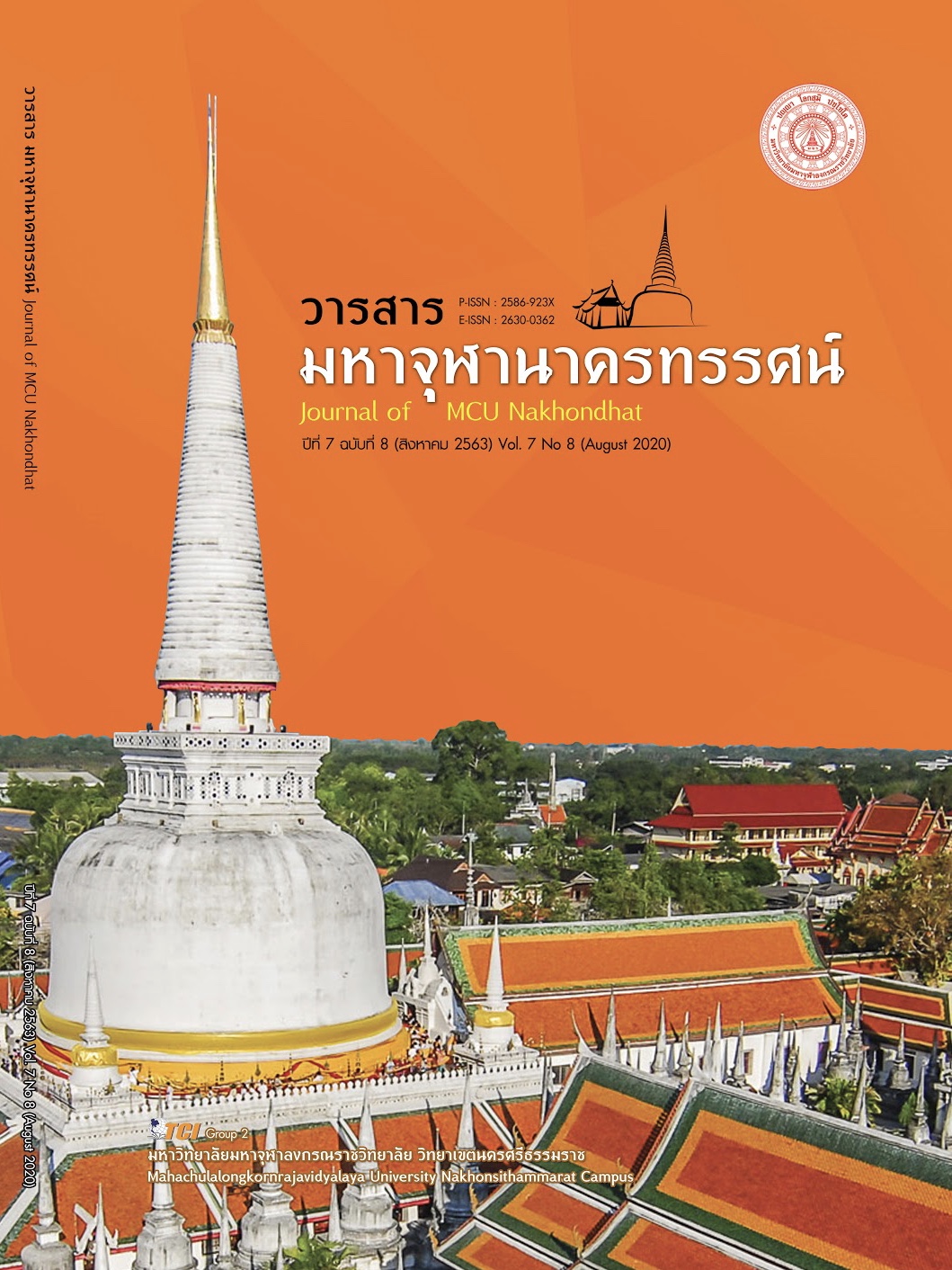AN ANALYTICAL STUDY THE SIGNS THAT APPEARED IN THE SHADOW PLAY OF THE NANG NAKHARIN CHATONG
Main Article Content
Abstract
This research has three objectives. Firstly, it is to study the life of work of the puppeteer Nakharin Chatong. Secondly, it is to examine the signs he has used in this shadow puppet shows.Thirdly, it is to analyze the meanings of the signs and Buddhist dharma in such shows.This is qualitative research focusing on observation and in – depth interviews presenting by a descriptive method. The results are as follows: 1) The puppeteer Nakharin Chatong was raised to love the indigenous art of shadow puppetry. He is talented in composing literature, puppeteering, and dubbing both central Thai dialect and more than 20 southern Thai dialects.He has used “Nai Tho”as his signature, main character in the play.His art has brought joy, entertainment, news, information, life philosophy, and Buddhist dharma to his audience. He was able to revive the old kind of shadow puppetry, to help raise awareness regarding the natural resource preservation in the Songkhla lake, and to help develop the southern border communities. He has received several awards for his remarkable talents and community services. 2) He has used two types of signed in complex and harmonious ways to communicate with his audience. First, it is the signs that are the components, including the theatre, canvas, musical instruments, crew members, worshiping and opening ceremonies, and puppets themselves.Second, it is the signs that are literature, including the stories of kon tawan cha lap fa, Say Than Hang Kham Rak, Rak Tho Ra Man, Thep Pha Bud Dern Din and Ma Ha Cha Nok. 3) There are two kinds of the meanings of the signs. First, it is the direct meaning, in which the audience would understand through the puppeteer’s voice immediately. Second, it is the implied meanings, in which the audience would have to analyze them first. Both the signs that are the components and that are the literature are imbued with Buddhist dharma of many kinds throughout.
Article Details
References
เกษม ขนาบแก้ว. (2544). ภูมิปัญญาการสอนหลักธรรมในพระพุทธศาสนาที่ปรากฏในบทหนังตะลุง ของหนังฉิ้น อรมุต: กรณีศึกษาเชิงวิเคราะห์. ใน รายงานการวิจัย. ฝ่ายวิจัยและเผยแพร่สำนักศิลปวัฒนธรรม สถาบันราชภัฏสงขลา.
บุษกร บิณฑสันต์. (2554). ดนตรีภาคใต้: ศิลปินการถ่ายทอดความรู้ พิธีกรรมและความเชื่อ. กรุงเทพมหานคร: สำนักพิมพ์แห่งจุฬาลงกรณ์มหาวิทยาลัย.
ปรวรรณ ดวงรัตน์. (2557). สัญญศาสตร์และความหมายที่แปรเปลี่ยน. วารสารสุทธิปริทัศน์, 28 (88), 1–14.
พระมหาอนุรักษ์ อภิรกฺโข (เจ้ยทอง). (2550). หนังตะลุงกับการเผยแผ่ธรรมแก่ประชาชน: กรณีศึกษาหนังตะลุงคณะสุรเชษฏ์ บันเทิงศิลป์ จังหวัดนครศรีธรรมราช. ใน วิทยานิพนธ์พุทธศาสตรมหาบัณฑิต สาขาวิชาพระพุทธศาสนา. มหาวิทยาลัยมหาจุฬาลงกรณวิทยาลัย.
วรรณา ปูป็ง. (2546). ศึกษาวิถีชีวิตชาวนครศรีธรรมราชจากบทหนังตะลุง. ใน รายงานการวิจัย. มหาวิทยาลัยรามคำแหง.
สันติภาพ ศิริวัฒนไพบูลย์. (2553). นิเวศวัฒนธรรม: การเรียนรู้ความสมดุลระหว่างวิทยาศาสตร์กับจิตวิญญาณ. อุดรธานี: มหาวิทยาลัยราชภัฏอุดรธานี.
สืบพงศ์ ธรรมชาติ และคณะ. (2559). การศึกษาวิเคราะห์หลักธรรมทางพระพุทธศาสนาที่ปรากฏในเนื้อเรื่องหนังตะลุงภาคใต้. วารสารมหาจุฬานาครทรรศน์, 3 (1), 72–86.
อภิญญา เฟื่องฟูสกุล. (2551). มานุษยวิทยาศาสนา แนวคิดพื้นฐานและข้อถกเถียงทางทฤษฎี. เชียงใหม่: มหาวิทยาลัยเชียงใหม่.


